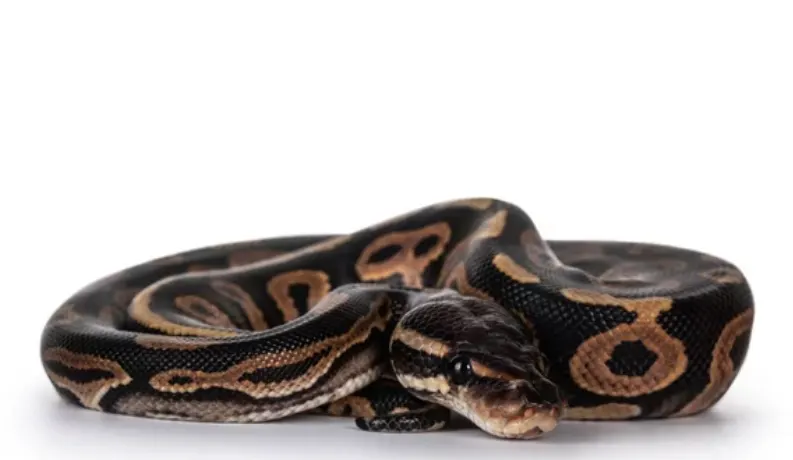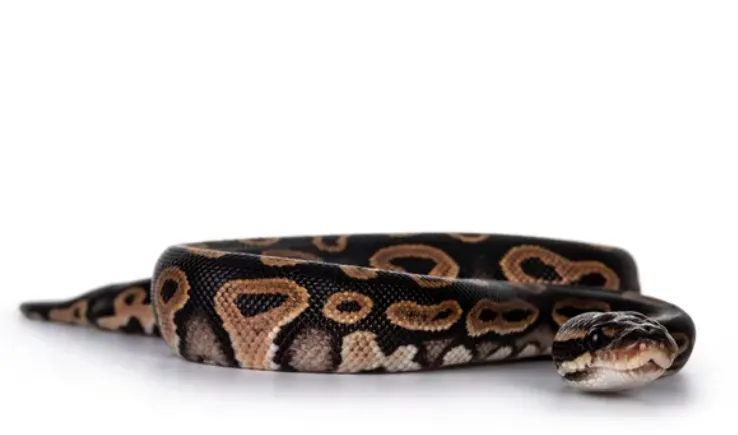The Cinnamon Ball Python, scientifically known as Python regius, is a unique and popular morph of the Ball Python species. Renowned for its warm, reddish-brown coloration and distinctive keyhole patterning, the Cinnamon Ball Python is a favorite among reptile enthusiasts. This blog post will provide an in-depth look at the Cinnamon Ball Python, covering its origins, physical characteristics, behavior, habitat, and care requirements.
Table of Contents
Origins and History
The Cinnamon Ball Python was first produced in 2002 by Graziani Reptiles, Inc., a reptile breeding company based in Venus, Florida. The cinnamon morph was originally named “cinnamon pastel” to differentiate it from the already-existing black and pastel morphs. However, Greg Graziani, the breeder behind this morph, later shortened the name to simply “cinnamon” to reflect its distinct characteristics better.
The Cinnamon Ball Python is an incomplete dominant morph, meaning it can be combined with other morphs to create new and unique patterns and colors. Over the years, breeders have used the cinnamon gene to produce various designer morphs, such as the Banana Cinnamon, Cinnamon Pinstripe, and Black Pastel Cinnamon.

Physical Characteristics
One of the most striking features of the Cinnamon Ball Python is its reddish-brown coloration. Unlike other Ball Python morphs that may display vibrant yellows or golds, the cinnamon morph is predominantly reddish-brown with dark brown, tan, and cream accents. The unique keyhole or bullseye-shaped markings further distinguish this morph from others. These markings consist of large, rounded brown splotches with a single dark brown or black spot in the center.
Cinnamon Ball Pythons typically have dark brown heads with light beige eye stripes and minimal blushing. They lack the typical pale, faded spot on the top of the head seen in other morphs. The overall patterning is well-defined and distinct, making the Cinnamon Ball Python a visually appealing snake.
In terms of size, Cinnamon Ball Pythons are similar to other Ball Pythons, with an average length of 5 to 6 feet. They have a lifespan of 20 to 30 years when properly cared for in captivity.
Behavior and Temperament
Ball Pythons, including the cinnamon morph, are known for their docile and gentle nature. They are curious and hardy snakes, making them ideal pets for both novice and experienced reptile keepers. Cinnamon Ball Pythons are nocturnal, meaning they are most active during the night. Despite their nocturnal tendencies, they adapt well to handling during the day and are generally calm and tolerant of human interaction.
One of the most endearing behaviors of Ball Pythons is their tendency to curl into a tight ball when they feel threatened or stressed. This defensive posture is where the species gets its common name, “Ball Python.” This behavior, along with their small size and lack of venom, makes them one of the least dangerous snakes to humans.
Habitat and Distribution
In the wild, Ball Pythons are native to the forests, grasslands, and savannas of western and central Africa, primarily in the Sub-Saharan region. Their natural habitat is characterized by warm temperatures and moderate humidity levels. While base morphs like the Cinnamon Ball Python can theoretically occur in the wild, such instances are extremely rare.
In captivity, Cinnamon Ball Pythons require a carefully controlled environment to thrive. A suitable enclosure should maintain temperatures between 75°F and 95°F, with a basking spot at the higher end of the range. Humidity levels should be kept between 50% and 60%, with a slightly higher level during shedding periods.
Diet and Feeding
Cinnamon Ball Pythons, like all Ball Python morphs, are carnivorous snakes. Their diet consists primarily of small rodents, such as mice and rats. In the wild, they may also prey on birds, amphibians, and occasionally fish. In captivity, it is important to provide a diet that closely mimics their natural
Young Cinnamon Ball Pythons should be fed appropriately sized prey every 5 to 7 days, while adults can be fed every 7 to 14 days. Prey items should be no larger than the widest part of the snake’s body to prevent injury during feeding. It is also advisable to feed pre-killed or frozen-thawed prey to avoid potential harm to the snake from live prey.
Health and Common Issues
Cinnamon Ball Pythons are generally healthy and hardy snakes, but they can experience some genetic issues due to their morph. One such issue is the “duckbill” deformity, where the snake’s lips are slightly misshapen, giving them a duckbill-like appearance. Another issue that can occur is mild tail kinking, where the tail has slight bends or kinks. These genetic mutations are more common in the super cinnamon morph, which results from breeding two cinnamon snakes together.
These issues are usually minor and do not significantly impact the snake’s quality of life. Regular veterinary check-ups and proper care can help ensure that your Cinnamon Ball Python remains healthy and thrives in captivity.
Breeding and Reproduction
Breeding Cinnamon Ball Pythons is a popular practice among reptile enthusiasts, particularly those interested in creating new and unique morphs. The cinnamon gene is incomplete dominant, meaning that when a cinnamon snake is bred with a non-cinnamon snake, approximately 50% of the offspring will inherit the cinnamon trait.
When two cinnamon snakes are bred together, the result is a super cinnamon morph, which has a more solid and uniform coloration with fewer pattern variations. However, as mentioned earlier, super cinnamon morphs are more prone to genetic issues like duckbill deformities and tail kinking.
Breeding should only be undertaken by experienced keepers who have a thorough understanding of the genetics involved and are prepared to care for both the adult snakes and the offspring.

Cinnamon Ball Python as Pets
Cinnamon Ball Pythons are a popular choice among reptile keepers due to their striking appearance, manageable size, and gentle temperament. They are relatively easy to care for, making them suitable for both beginners and experienced keepers. Additionally, their unique coloration and pattern make them a visually appealing addition to any reptile collection.
When purchasing a Cinnamon Ball Python, it is important to buy from a reputable breeder to ensure that you are getting a healthy snake. Prices for Cinnamon Ball Pythons can range from $80 to $150, depending on the snake’s age, size, and the presence of any additional traits.
The Cinnamon Ball Python is a fascinating and beautiful morph that has captured the hearts of reptile enthusiasts worldwide. With its warm, reddish-brown coloration, distinctive keyhole patterning, and gentle nature, it is no wonder that this morph has remained popular since its introduction in 2002. Whether you are a seasoned reptile keeper or a newcomer to the hobby, the Cinnamon Ball Python is a wonderful addition to any collection.
- Enchi Ball Python: A Unique and Stunning Morph of Python regius - March 27, 2025
- Emerald Tree Monitor: The Enigmatic Green Guardian of the Rainforest - March 26, 2025
- The Egyptian Cobra (Naja haje): A Fascinating Serpent - March 25, 2025
